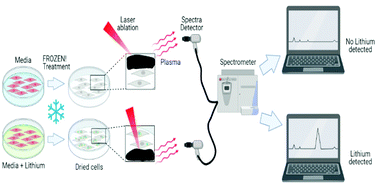FROZEN! Intracellular multi-electrolyte analysis measures millimolar lithium in mammalian cells†
Abstract
Lithium salts are commonly used as medication for Bipolar Disorder (BD) and depression. However, there are limited methods to quantify intracellular lithium. Most methods to analyze intracellular electrolytes require tedious sample processing, specialized and often expensive machinery, sometimes involving harmful chemicals, and a bulk amount of the sample. In this work, we report a novel method (FROZEN!) based on cell isolation (from the surrounding medium) through rapid de-ionized water cleaning, followed by flash freezing for preservation. SKOV3 cells were cultured in normal medium and a medium containing 1.0 mM lithium. Lithium and other intracellular electrolytes in the isolated and preserved cells were simultaneously analyzed with laser-induced breakdown spectroscopy (LIBS) and X-ray fluorescence spectroscopy (XRF). Key electrolytes such as sodium, potassium, and magnesium, along with lithium, were detectable at the single-cell level. We found that cells cultured in the lithium medium have an intracellular lithium concentration of 0.5 mM. Concurrently, the intracellular concentrations of other positively charged electrolytes (sodium, potassium, and magnesium) were reduced by the presence of lithium. FROZEN! will greatly facilitate research in intracellular electrolyte balance during drug treatment, or other physiological stresses. In particular, the cell isolation and preservation steps can be easily performed by many laboratories worldwide, after which the samples are sent to an analytical laboratory for electrolyte analysis.



 Please wait while we load your content...
Please wait while we load your content...